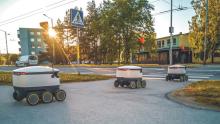- Support portal
- Evaluation Kits and partner products
u-blox Support
- Product documentation
Documentation
- Investor relations
Investor relations
Innovation
|
30 Sep 2016
Autonomous driving – Here today, and tomorrow for everyone
Autonomous driving – Here today, and tomorrow for everyone

Autonomous driving vehicles are on the road today. To name just a couple of examples, Volvo has already launched autonomous driving trials on the streets of Gothenburg, close to its headquarters, and has announced plans to extend trials to London and China. Google’s self-driving cars, on the other hand, have amassed close to two million autonomous miles driven, according to the company’s latest report. Even those of us not lucky enough to be involved in ground-breaking pilots like these can appreciate how our cars are beginning to relieve us of tricky tasks such as parking, or handle situations that require instant reaction – emergency braking and collision avoidance.
As an increasing number of “helpful” vehicles permeate the market, today’s consumers can now begin to understand that autonomous driving systems cover a spectrum ranging from those that provide minor assistance, through various levels of automation, to completely autonomous self-driving robotic vehicles. Some advantages are guaranteed: insurance premiums will fall dramatically as a result of improved safety. Given that up to 90% of road-traffic accidents are reckoned to be the result of human error, it follows that minimizing the role of the driver will reduce collisions, leading to lower repair bills and medical costs. Additional potential benefits include cleaner air, less congestion, and greater safety for pedestrians and cyclists.
As stakeholders begin to come to terms with the changes and opportunities that autonomous vehicles present, technical improvements are needed in almost every aspect of controlling and localizing the vehicle, and recognizing other road users, nearby objects, and events – some routine, some exceptional – that occur continuously in the car’s vicinity.
At u-blox, we see lane-accurate GNSS as being an instrumental part of the technology mix needed to realize the ultimate potential of autonomous driving. While traditional positioning techniques such as landmark recognition are very strong, they have shortcomings in situations where there is a lack of suitable landmarks. In addition, only satellite-based technology such as GNSS can provide absolute position, velocity and heading.
The fact is that autonomous driving needs to use a variety of positioning techniques in combination, in order to fully satisfy requirements for instant availability, high accuracy, safety and integrity. Integrity is extremely important, because autonomous driving needs to be able to trust the information coming from GNSS, with a confidence level much higher than today.
By developing lane-accurate GNSS, we will also offer advantages such as lower mapping costs (thanks to reduced requirements for details), the opportunity to crowd-source maps cost-effectively, and eliminate the effects of weather-related changes such as snowfall that can obscure landmarks or other recognizable features. Enhanced, lane-accurate GNSS is also important for maintaining calibration of the vehicle’s sensors.
The key to delivering the required improvements in GNSS accuracy lies in bringing together multiple GNSS technologies. SSR-RTK (State Space Representation, Real-Time Kinematic) algorithms, for example, are critical for high-speed, high-accuracy positioning; multi-GNSS systems are able to manage a large numbers of measurements from various constellations (multi-paths mitigation & plausibility checks) and multi-band reception techniques that help dramatically minimize convergence times down to a few seconds. By combining enhanced satellite-based positioning with 3D automotive dead reckoning, tomorrow’s positioning systems will work much better in challenging places such as canyons, obstructions, and driving in tunnels or covered parking areas.
We are developing GNSS solutions that are accurate down to <10 centimeters within a few seconds, using an SSR correction service also provided by u-blox and his partners. The integrity (i.e. confidence the user can place in GNSS) will be at unreached levels (several magnitudes better than today).
The market’s acceptance of these advanced technologies will also be determined by cost & quality. As the market leader in automotive GNSS, u-blox has a clear advantage; by bringing the benefits of lane-accurate GNSS to a variety of advanced vehicle applications, such as V2X and high-accuracy navigation, we can hasten the era of accessible, affordable, sustainable mobility through autonomous driving.
Franck Berny
Automotive Market Development Positioning, u-blox



